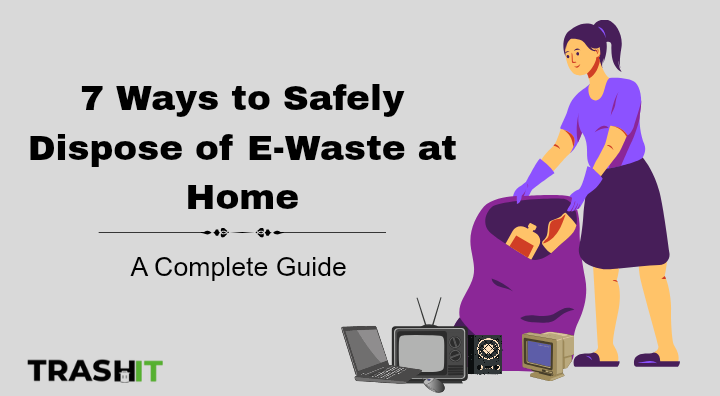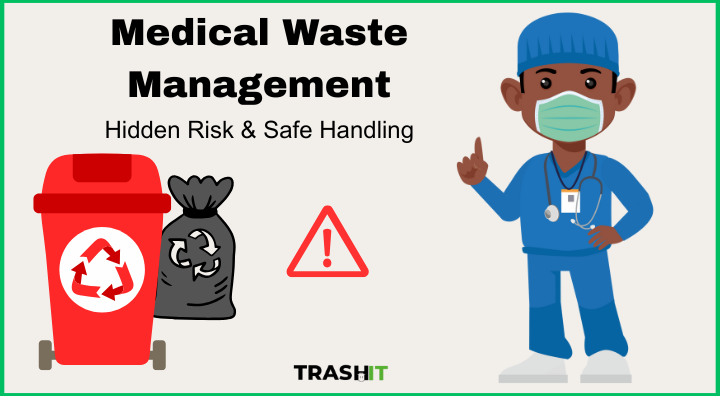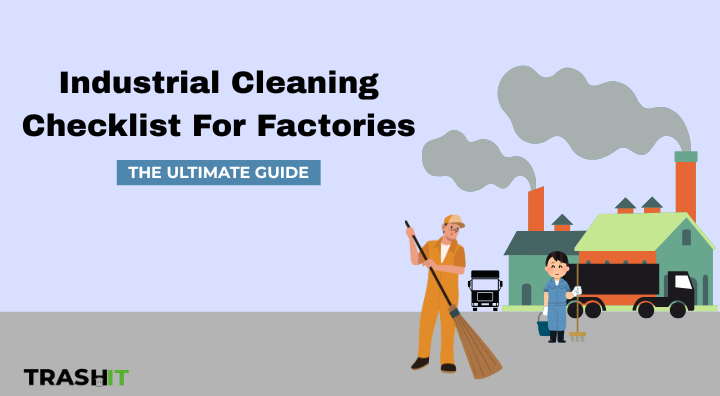
Looking for professional industrial cleaning or consultation services? Visit TrashIt for service and consultation today.
Have you thought about an industrial cleaning checklist that factories can use?
Industrial cleaning might not be the most glorious part of running a factory…, but it’s one of the most critical of important parts every factory needs.
A clean factory is not just about appearances; it’s about…
- Safety
- Compliance
- Efficiency
- Profitability
Dust can build up, which can lead to equipment malfunction; oil residues can cause slip hazards, and poor sanitation can lead to contamination, especially in food or pharmaceutical manufacturing.
In this guide, I will give you a comprehensive industrial cleaning checklist for factories.
It will be broken down by frequency, area, and task type.
If you are managing a small production floor or a large multi-department facility, this checklist I am about to share with you will help you and your team maintain a spotless, compliant, and efficient operation.
Let’s talk more about industrial cleaning and why it matters.
Keep reading…
Why Industrial Cleaning Matters
1; Safety and Compliance
One of the primary drivers behind industrial cleaning is regulatory compliance.
Agencies like OSHA (Occupational Safety and Health Administration) and international standards like ISO 45001, require factories in order to maintain safe and hygienic environments to protect workers and prevent contamination.
Safety Risks of Poor Cleaning:
- Oil or grease spills, which can cause a slippery floor
- Dust explosions in manufacturing environments
- Food and chemical plants can have cross-contamination
- Fire hazards can occur due to the buildup around electrical equipment
A proper cleaning schedule can reduce or remove these risks and help make sure that you meet industry safety standards.
2; Equipment Longevity and Efficiency
Machinery downtime can cost money. Dust, dirt, and residue buildup can clog filters, wear down moving parts, and cause equipment overheating.
According to Plant Engineering Magazine, poor cleaning and maintenance are responsible for nearly 30% of unplanned downtime in manufacturing environments.
With regular cleaning, it will keep your machines performing at peak efficiency, which will prolong their lifespan and minimize maintenance costs.
3; Product Quality and Customer Trust
In the pharmaceuticals, food processing, or electronics industries, cleanliness is directly tied to product quality.
Contamination or defects can lead to product recalls, fines, and reputational damage.
When an industry maintains strict cleaning protocols, it will demonstrate industry professionalism and build customer trust.
Need help implementing your cleaning program? Get in touch with our industrial cleaning specialists at TrashIt Contact Page
The Complete Industrial Cleaning Checklist for Factories
If you look at the comprehensive checklist below…, you can adapt it to your facility’s size, industry, and workflow.
To make it easier, I have divided it into daily, weekly, monthly, and quarterly cleaning tasks…
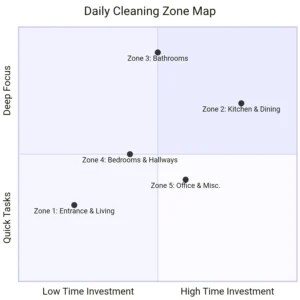
Daily Cleaning Tasks
These are necessary when it comes to maintaining basic hygiene and preventing the accumulation of dirt and debris.
Factory Floors
- At the end of each shift, sweep and mop all walkways and work areas.
- You should immediately remove oil, chemical or product spills from the areas
- Ensure all spill kits are stocked and accessible.
- Inspect for trip hazards like cords or debris.
Workstations and Equipment
- Wipe down surfaces, benches, and tools.
- Always remove product residues, metal shavings, or dust.
- You should empty the trash and replace liners.
- Make sure you check that safety guards and cleaning supplies are in good condition.
Restrooms and Break Areas
- Disinfect sinks, toilets, and high-touch surfaces.
- Restock soap, paper towels, and toilet paper.
- Empty trash bins and clean floors.
Entrances and Exits
- Sweep entryways to prevent dirt tracking.
- Clean doormats and ensure proper lighting.
Pro tip: Assign specific cleaning zones to employees or departments to promote accountability.
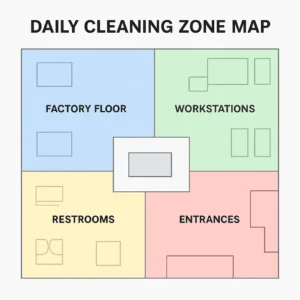
Weekly Cleaning Tasks
In weekly cleaning, you need to focus on areas that don’t require daily attention but are necessary for maintaining deeper cleanliness and safety.
Machinery and Equipment
- Clean machine surfaces, belts, and panels.
- Remove any residue buildup on conveyor systems.
- Apply lubricant on moving parts if necessary (as per manufacturer guidelines).
- Look and inspect for leaks or corrosion.
Storage and Supply Areas
- Reorganize shelves, racks, and inventory zones.
- Do check for expired or damaged materials.
- Clean and label storage bins properly.
Walls and Fixtures
- Wipe down walls, light fixtures, and overhead beams
- Remove cobwebs and accumulated dust.
Safety Equipment
- Clean and inspect fire extinguishers, eyewash stations, and safety showers.
- Make sure that first-aid kits are fully stocked.
- Check ventilation systems and replace filters if needed.
You can check OSHA safety station requirements by reading the OSHA Eye and Face Protection Standards.
Monthly Cleaning Tasks
These tasks are more focused on deep cleaning and preventive maintenance.
Floors and Drains
- Use pressure water to wash factory floors and loading docks.
- Clean and unclog drains to prevent waste issues.
- Apply floor sealant or anti-slip treatment if necessary.
Machinery Deep Clean
- Perform detailed cleaning of internal parts like fans, ducts and filters.
- Inspect motor housings, wiring, and bearings for buildup or damage.
- Replace air filters, coolant, and lubrication fluids where applicable.
Storage Tanks and Containers
- Empty and clean large tanks or hoppers.
- Check for signs of corrosion or contamination.
Ceilings, Lighting, and HVAC
- Clean overhead lights and replace burnt-out bulbs.
- Vacuum or wipe ventilation ducts and ceiling fans.
- Inspect HVAC filters and air quality.

Quarterly or Seasonal Cleaning Tasks
This is a seasonal deep cleaning preparation that helps you and your facility for changes in production cycles or environmental conditions.
Exterior Cleaning
- Use pressure water to wash building exteriors, windows, and loading bays.
- Check and inspect roofs and gutters for debris or leaks.
- Clean signage and repaint faded markings.
Inventory Areas
- Conduct a full inventory cleanup and reorganization.
- Sanitize storage racks, pallets, and containers.
Waste Management Systems
- Deep clean waste and recycling bins.
- Schedule hazardous waste disposal through certified vendors.
Safety Audit and Review
- Review and update your cleaning logbooks.
- Evaluate cleaning supplies and replace ineffective products.
- Conduct refresher training for cleaning and safety staff.
To learn more about EPA’s industrial waste management guidelines, read, EPA Waste Management Standards.
Specialized Cleaning Procedures
Have it in mind that, it is not all factory areas are the same.
Some areas require customized cleaning procedures depending on your industry and production type.
Food Processing Factories
- Sanitize all food-contact surfaces with FDA-approved disinfectants.
- Use colour-coded cleaning tools to prevent cross-contamination.
- Clean drains daily with enzymatic or chlorinated solutions.
Chemical Manufacturing Plants
- Use chemical-resistant PPE and equipment.
- Neutralize residues before cleaning.
- Follow hazardous waste disposal protocols strictly.
Metal Fabrication and Automotive Plants
- Remove grease and metal dust regularly to prevent fire hazards.
- Use degreasers on machinery surfaces.
- Clean ventilation systems to manage fumes.
Pharmaceutical and Cleanroom Facilities
- Follow GMP (Good Manufacturing Practice) standards.
- Maintain air filtration systems and pressure differentials.
- Use sterile wipes and approved cleaning agents.
Best Practices for Factory Cleaning Teams
1. Create and Maintain Cleaning Logs
It’s proper to document every cleaning activity like…
- What was cleaned
- When was it cleaned
- By whom was it cleaned
Logs serve as proof of compliance and help track performance.
Check out this article that discusses more on OSHA Recordkeeping Requirements.
2; Train and Certify Cleaning Staff
Make sure every staff member understands both safety protocols and industry regulations.
Do provide regular training on…
- Chemical handling
- PPE use
- Emergency response
3; Use the Right Cleaning Equipment
Budget and buy industrial-grade vacuums, pressure washers, and floor scrubbers designed for your environment.
Using household tools in industrial settings can lead to inefficiency or damage.
4; Adopt Environmentally Friendly Practices
Proper cleaning isn’t just good for the planet… It’s good for business.
Choose biodegradable detergents, reduce water waste, and recycle cleaning materials where possible.
5; Implement a 5S Approach
The 5S are…, Sort, set in order, Shine, Standardize, Sustain.
It is a manufacturing method that is used to improve cleanliness and organization.
Incorporate it into your cleaning culture.
Tools and Supplies Checklist
To make sure of consistency, every cleaning team should have access to the following supplies…
| Serial No | Category | Example Items |
|---|---|---|
| 1 | Basic Tools | Brooms, dustpans, industrial mops, vacuum cleaners |
| 2 | Machinery Cleaning | Brushes, degreasers, lubricants, and lint-free wipes |
| 3 | Safety Gear | Gloves, goggles, respirators, protective clothing |
| 4 | Disinfection | EPA-approved sanitizers, alcohol wipes, disinfectant sprays |
| 5 | Waste Management | Spill kits, labelled disposal bins, absorbent pads |
| 6 | Record keeping | Cleaning log sheets, checklists, and inspection forms |
Digital Tools for Modern Cleaning Management
In today’s data world, cleaning logs and checklists can go digital.
Modern facilities use software like:
- SafetyCulture (iAuditor): For mobile inspections and digital checklists
- Limble CMMS: For tracking maintenance and cleaning schedules
- FacilityDude or UpKeep: For real-time task management and reporting
These systems provide visibility, reduce human error, and make compliance audits much easier.
Common Industrial Cleaning Mistakes to Avoid
1. Skipping Routine Maintenance by waiting for visible dirt to appear before cleaning.
This can lead to costly downtime.
2. Using Incompatible Cleaning Products which contain certain chemicals that can corrode surfaces or react dangerously with residues.
3; Ignoring Air and Ventilation Systems can lead to dust buildup in ducts can impact air quality and pose fire risks.
4; Lack of Accountability, which can result in incomplete tasks due to not having cleaning assignments or logs.
5; Neglecting Staff Training can lead to poorly trained staff.
Poorly trained staff may use incorrect methods or chemicals, endangering both themselves and equipment.
Downloadable Resource: Industrial Cleaning Checklist for Factories (PDF)
To make implementation easier, we’ve created a free downloadable PDF version of this checklist. It includes:
- Daily, weekly, and monthly task lists
- Columns for staff initials and completion dates
- Space for additional notes or compliance checks
Conclusion
Industrial cleaning is not just about hygiene. It’s the foundation for operational excellence.
When you follow a structured checklist and instill a culture of cleanliness, you will be able to make sure your factory remains safe, compliant, and efficient.
A clean environment boosts employee morale, extends equipment life, and reinforces your brand’s credibility.
If you are the one managing a production line or a multi-site manufacturing network, have it in mind that… routine cleaning is a strategic investment in every business success.
If you’re ready to upgrade your cleaning systems, consider:
- Scheduling a professional audit
- Training your team on industrial hygiene standards
- Implementing the checklist from this guide
With the right structure, tools, and discipline, you’ll transform your factory from “just functional” to truly world-class.
Need Professional Help?
If you’d like expert assistance in industrial cleaning or want to schedule a consultation for your factory, contact us today at TrashIt. Let’s help you maintain a safe, compliant, and efficient facility.

